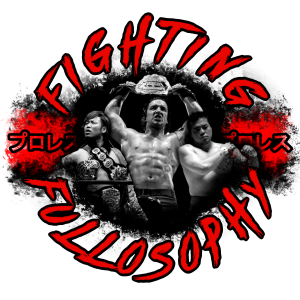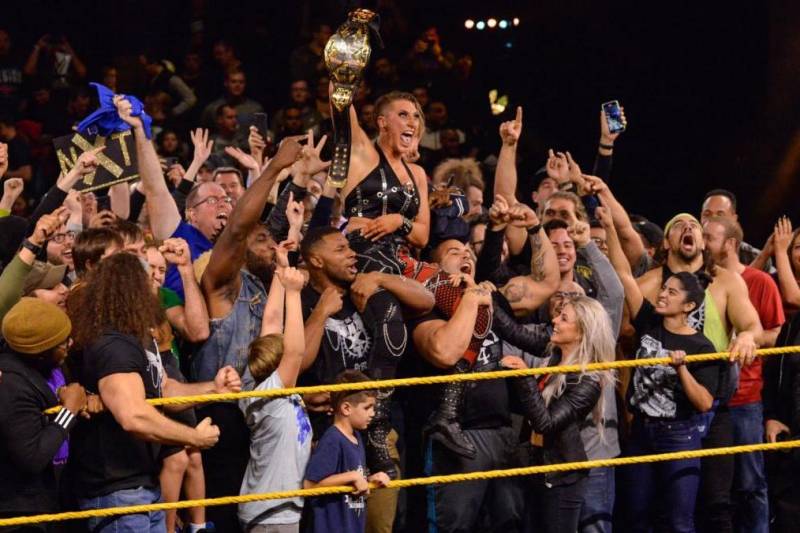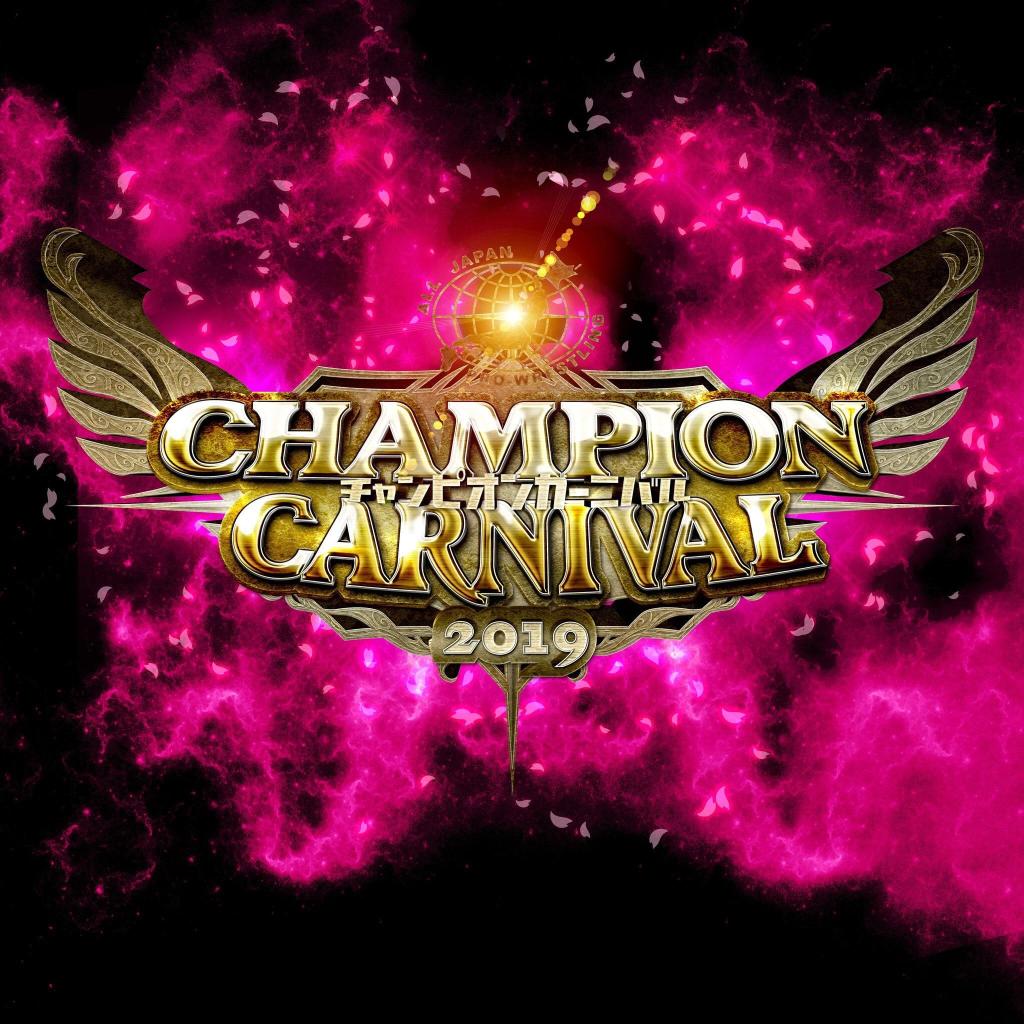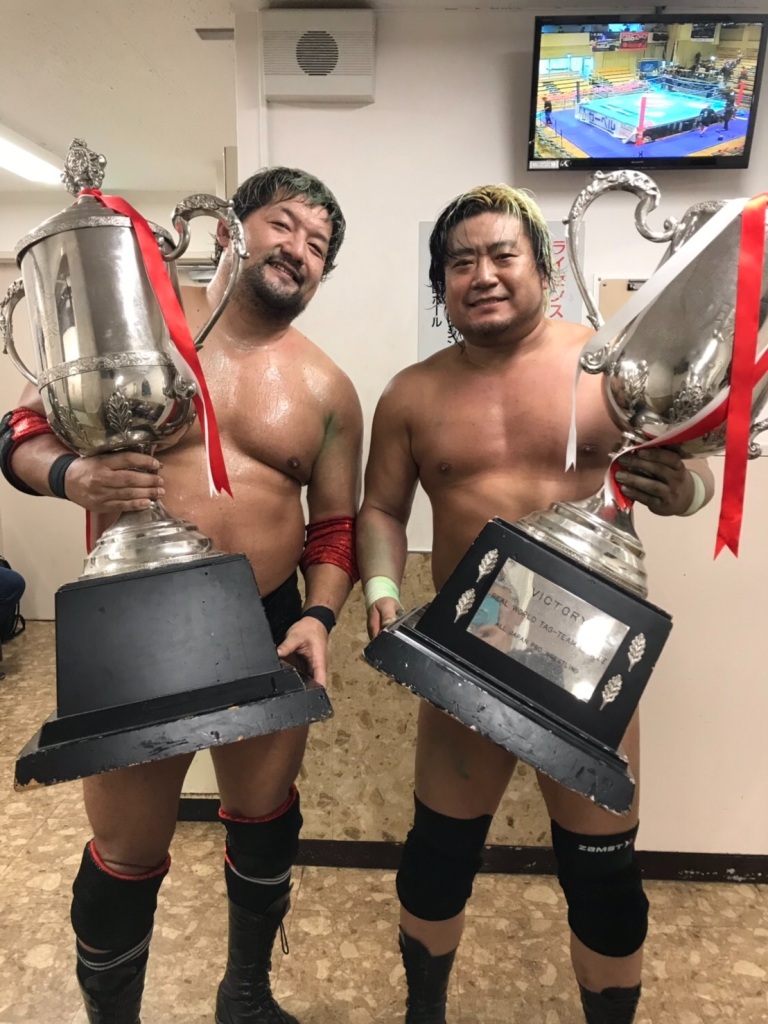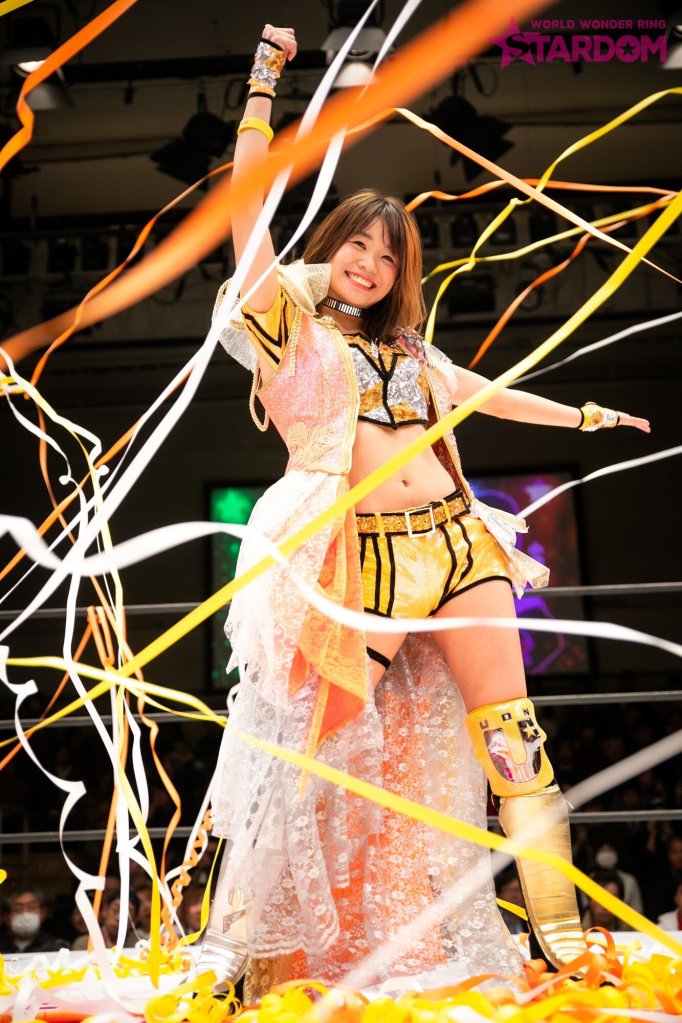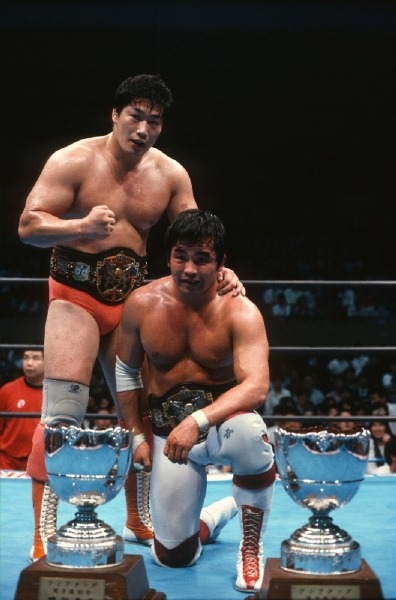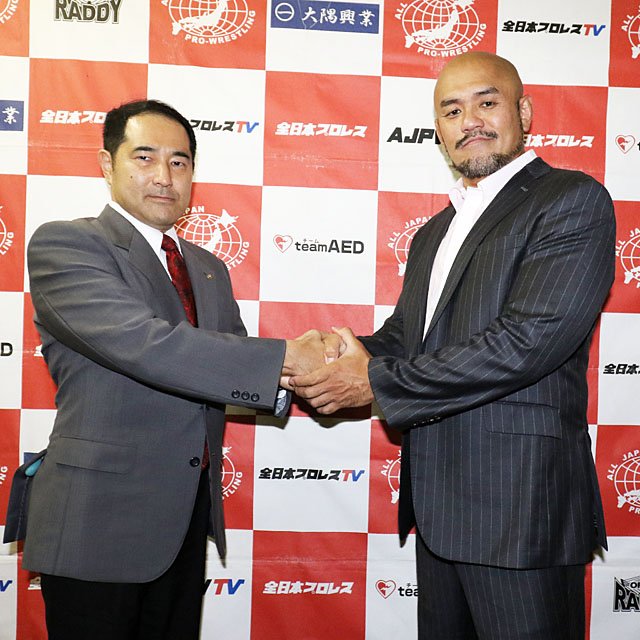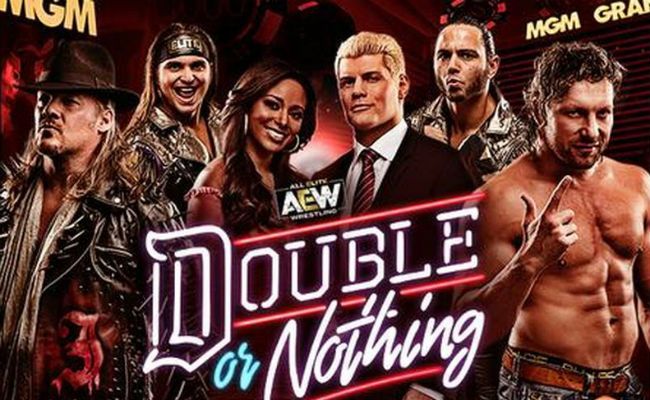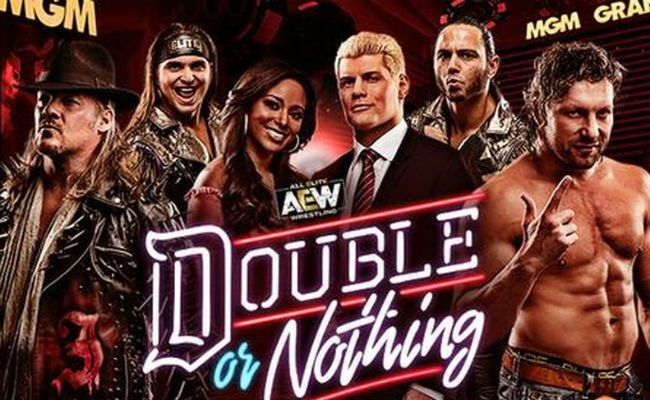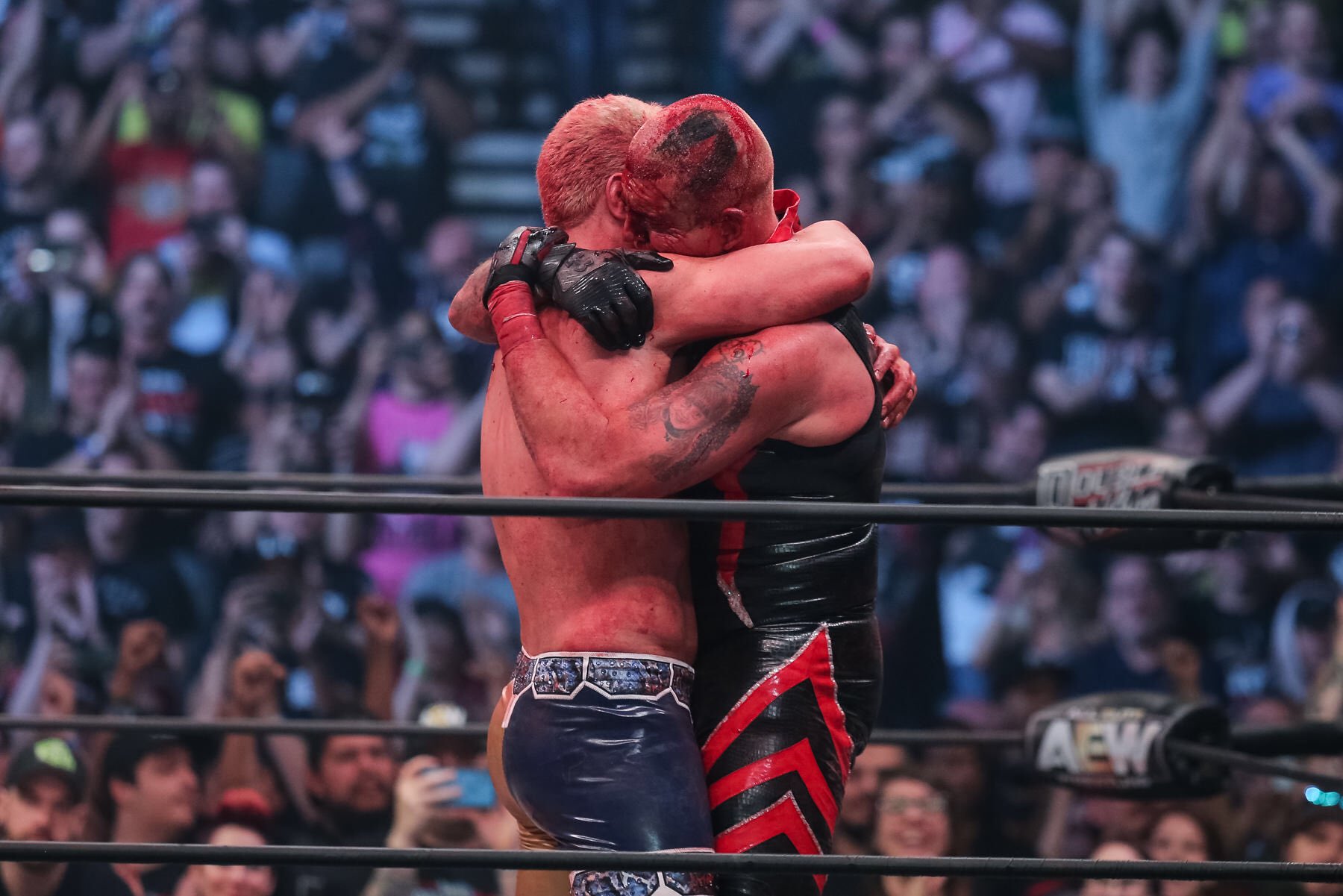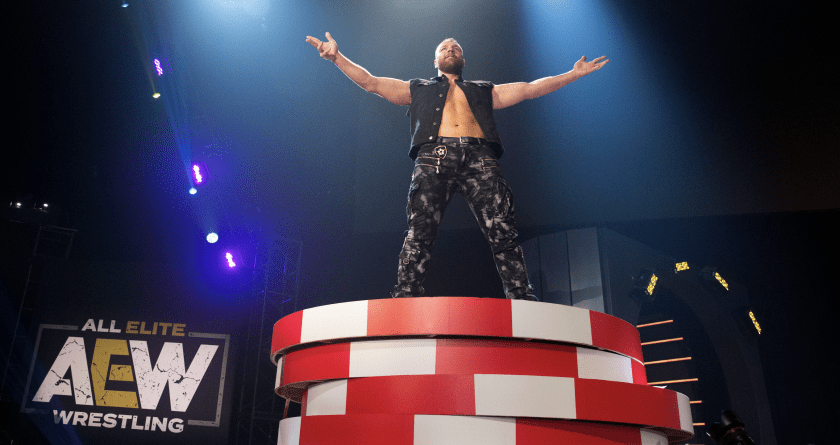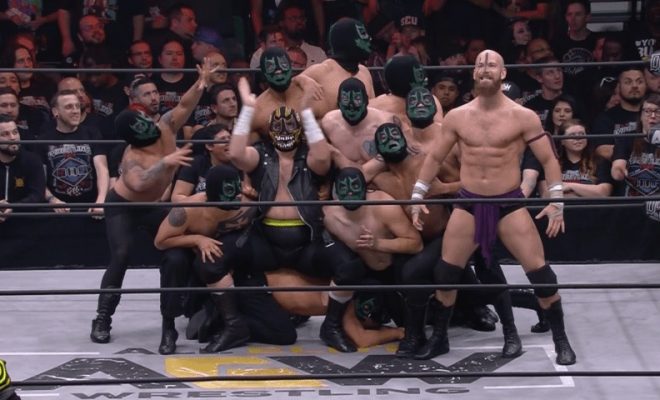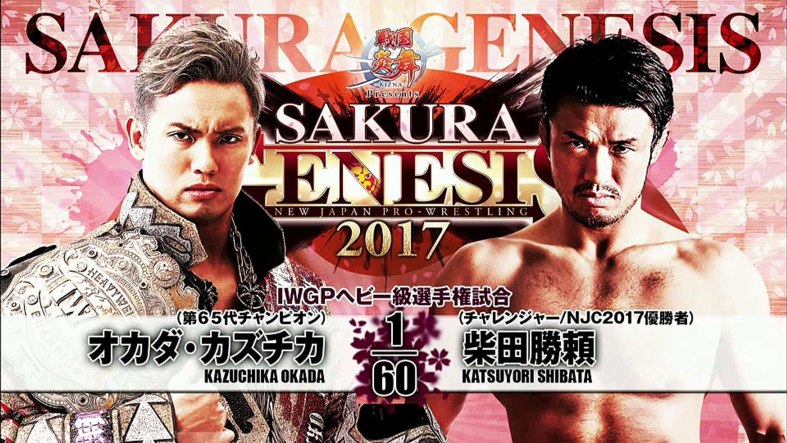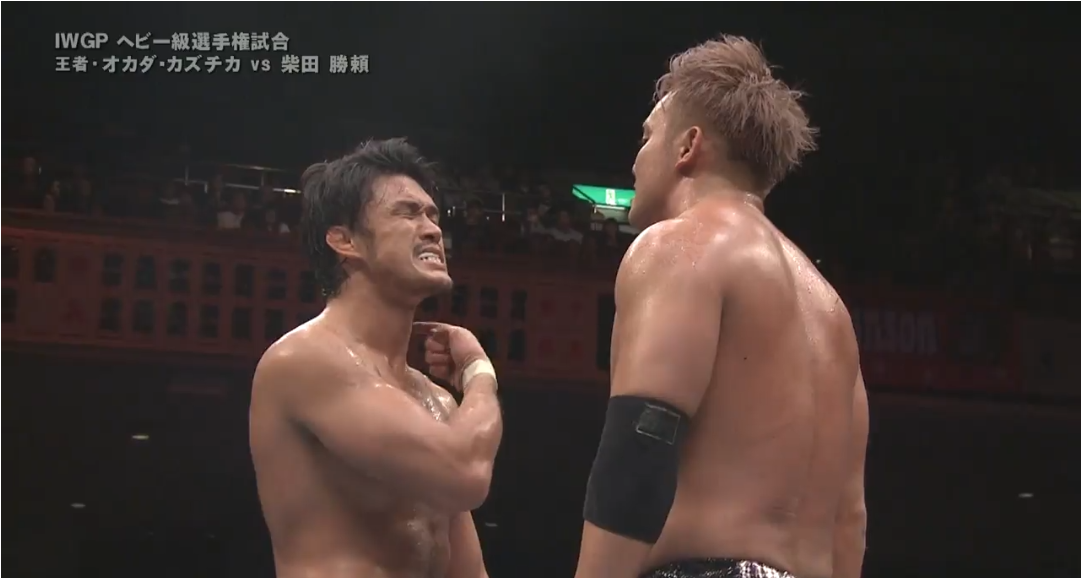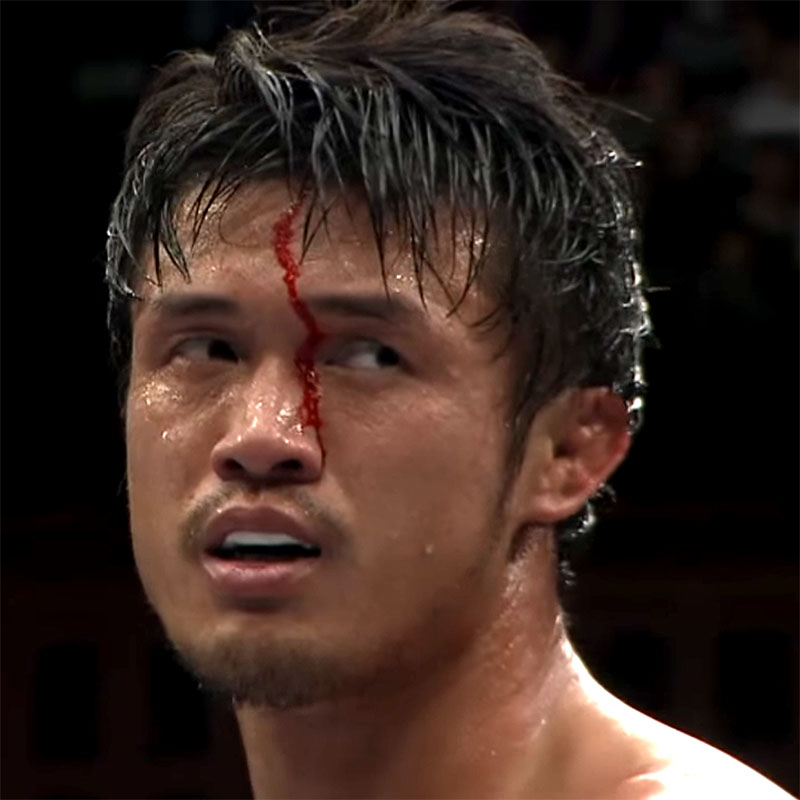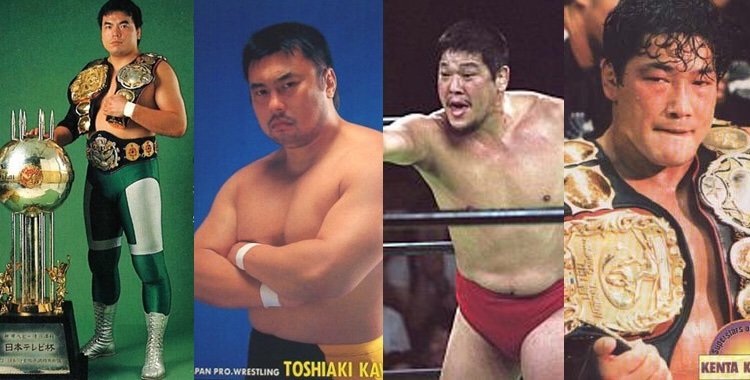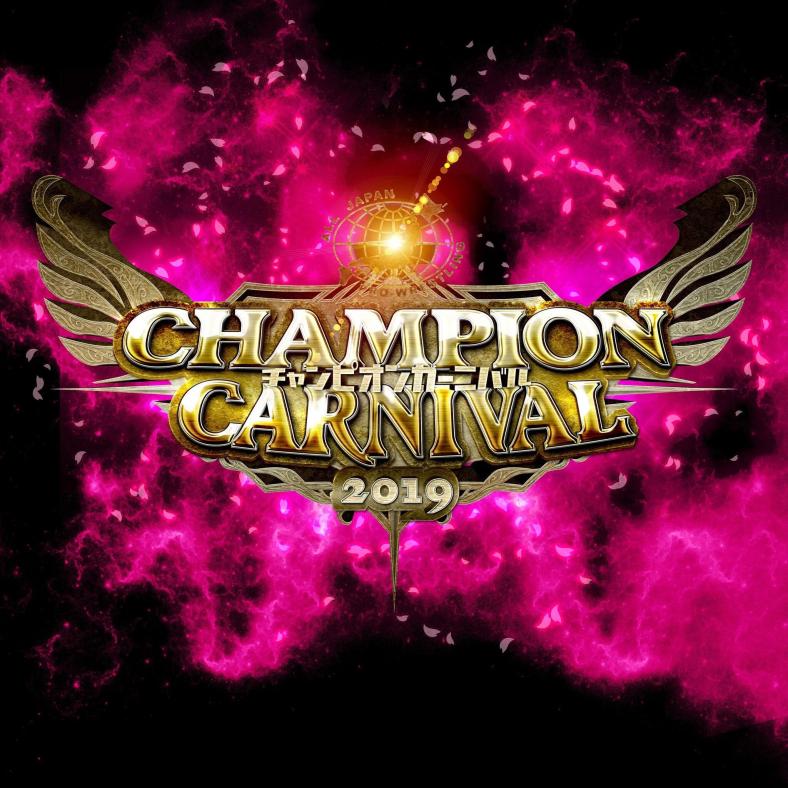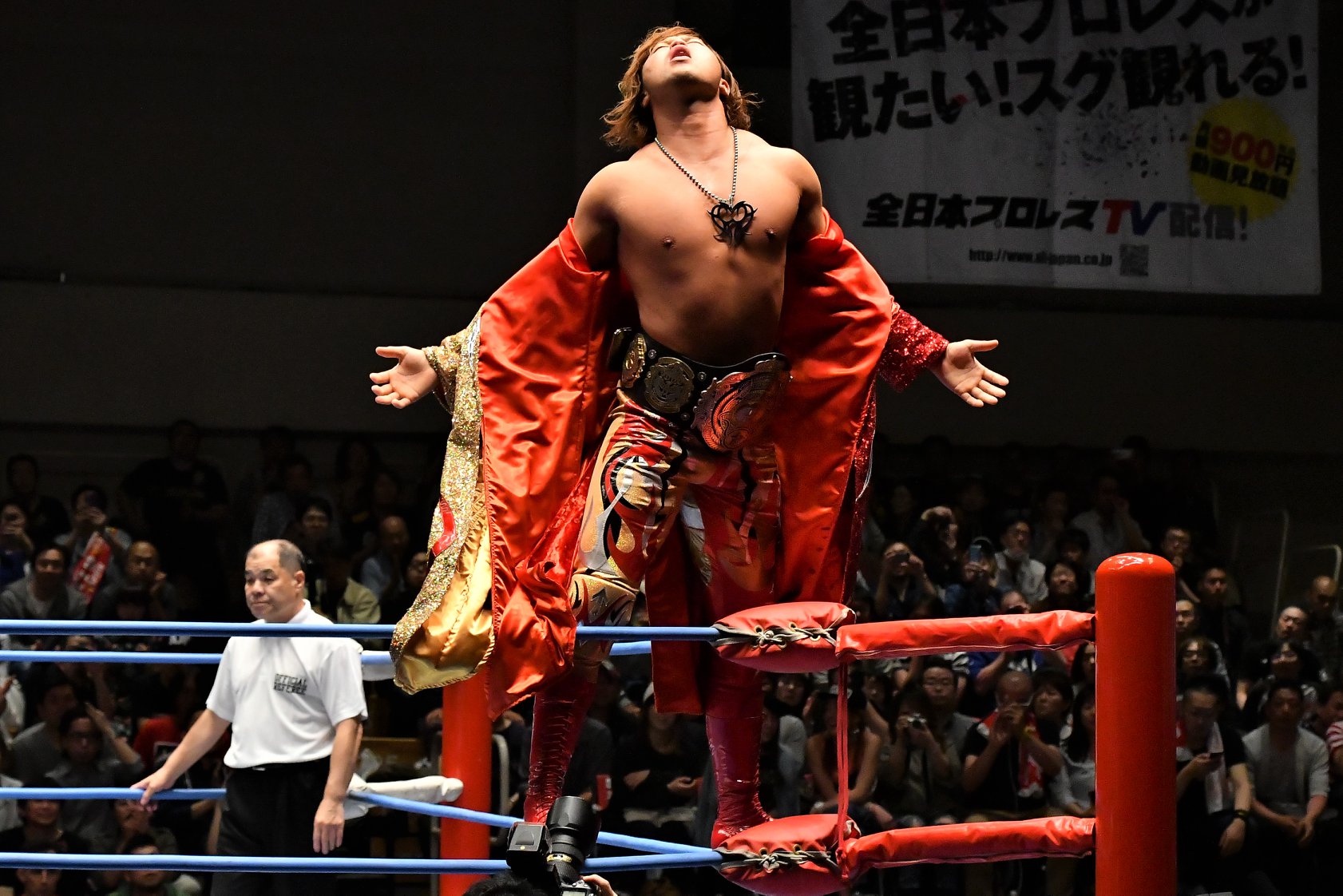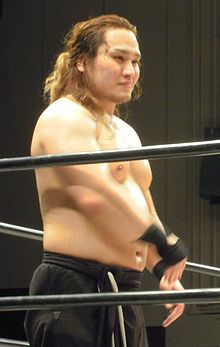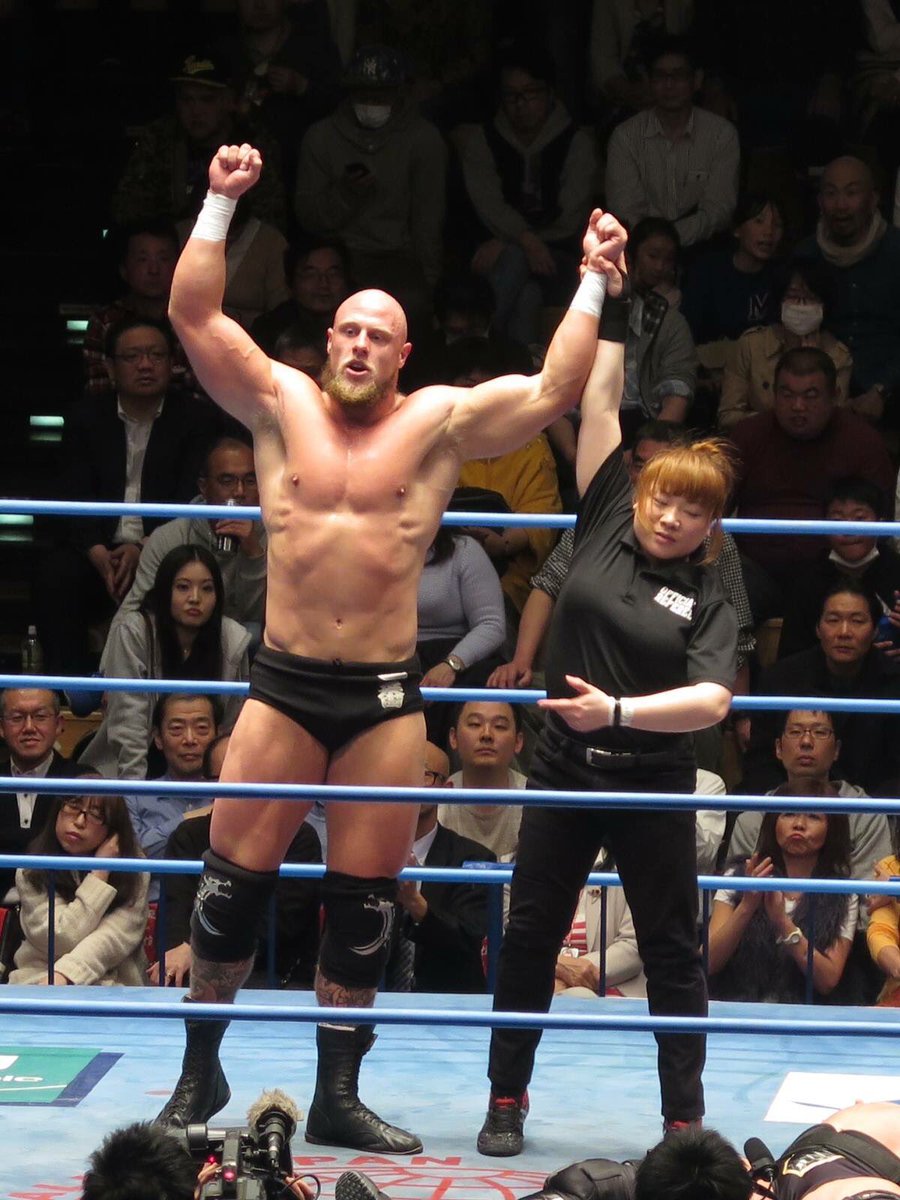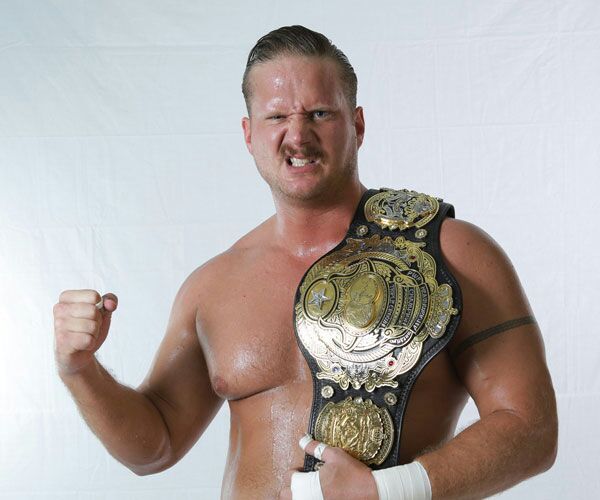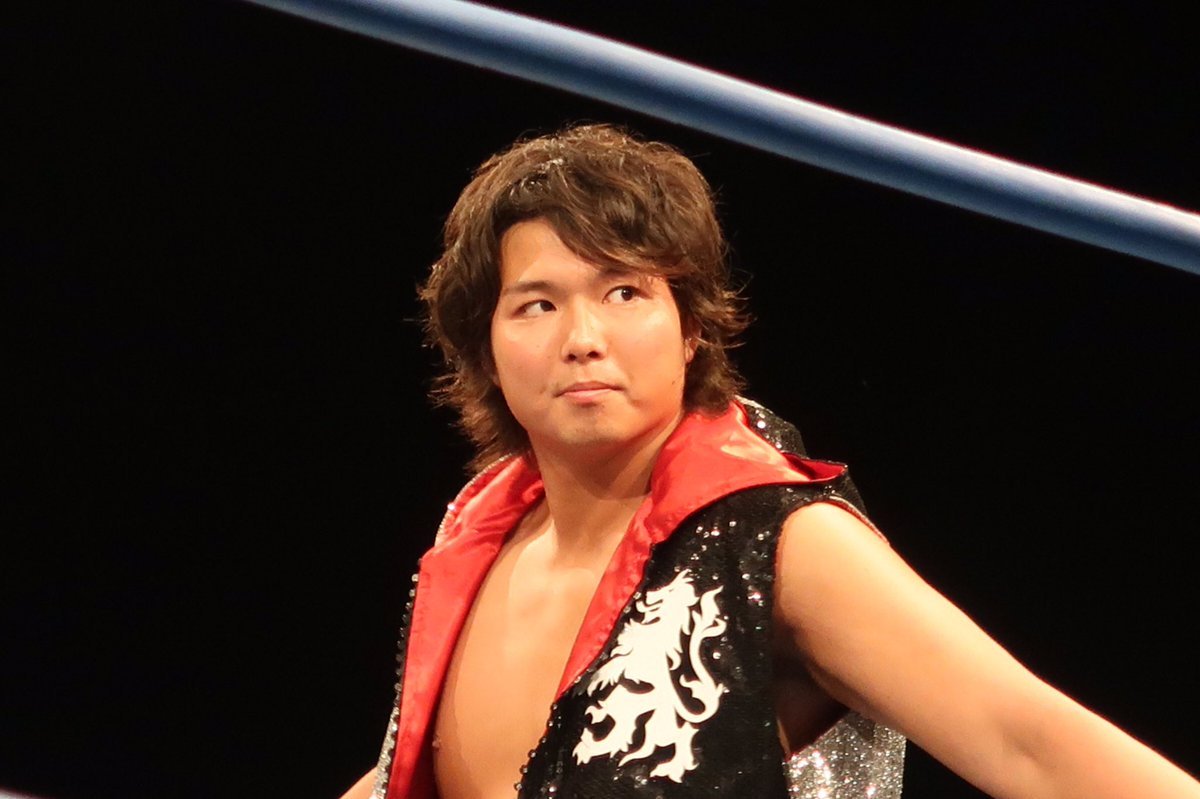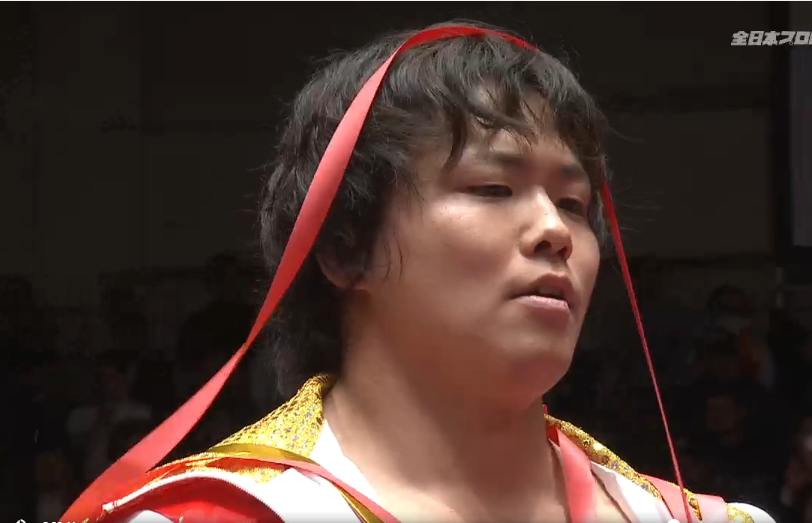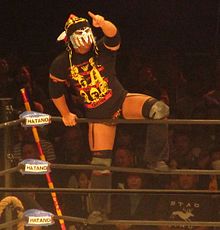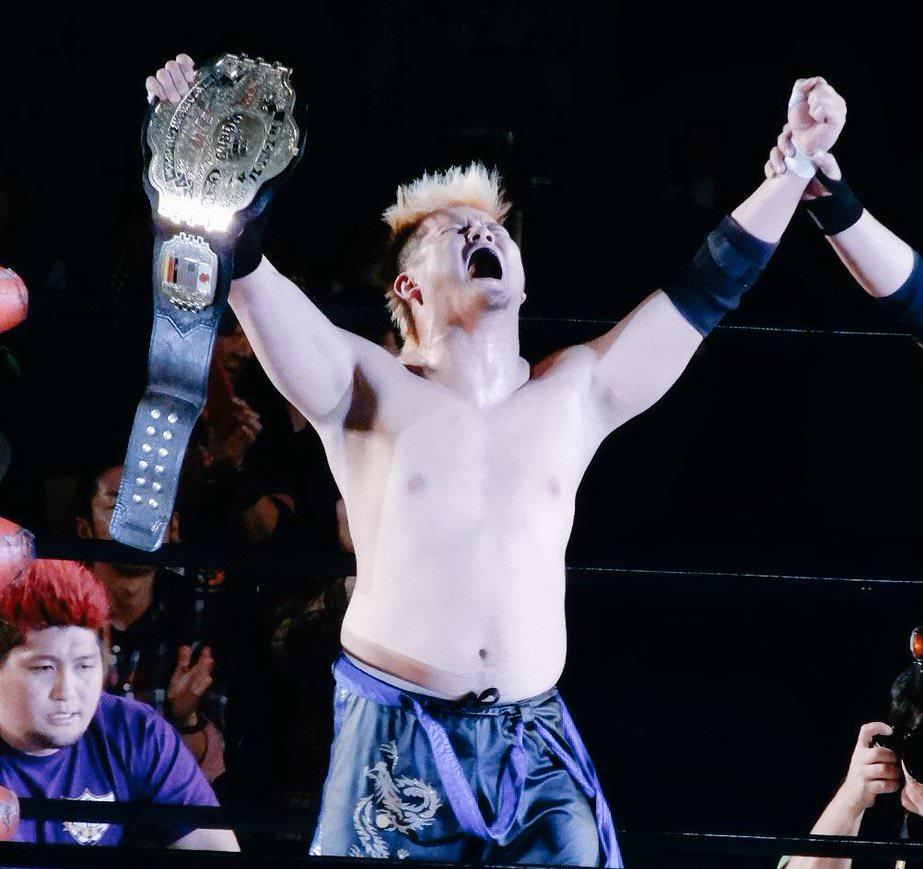
As I stated at the start of my Year End Awards, which can be found here, 2019 has been a year of discovery for me. It has reaffirmed my opinion that if you’re unhappy or frustrated with the current promotion you’re watching. Then explore the plethora of fantastic promotions that are easily accessible all over the world. While it can feel like a daunting task, there is community out there who want to share their love for a promotion and encourage others to share in that experience.
The only downside is it makes creating a “Top Matches” list incredibly difficult. Over the course of the year, this list has gone from a Top 20 to a Top 30 and now a Top 40. Even with this extended list, narrowing the field down to 40 has resulted in some excellent matches not making the cut.
Therefore, let’s kick this off with the honourable mentions.
Honourable Mentions
- IWGP Jr Heavyweight Title Match: Dragon Lee vs Will Ospreay – NJPW Dominion
- IWGP Jr Heavyweight Tag Title Match: LIJ vs Suzuki-Gun – New Beginning in Sapporo (Night 2)
- IWGP Intercontinental Title Match: Tetsuya Naito vs Kota Ibushi – G1 Supercard
- NXT UK Tag Team Title Match: Moustache Mountain vs Grizzled Young Veterans – NXT UK Takeover: Blackpool
- IWGP Heavyweight Title Match: Kazuchika Okada vs Jay White – G1 Supercard
- WWE Title Match: Daniel Bryan vs Kofi Kingston – WrestleMania 35
- Tomohiro Ishii vs Yoshi-Hashi – New Japan Cup (Night 9)
- GHC Junior Heavyweight Title Match: Daisuke Harada vs Minoru Tanaka – Great Voyage in Yokohama
- NXT Tag Team Title Match: Undisputed Era vs War Raiders – NXT Takeover: Phoenix
- Kazuchika Okada vs Michael Elgin – New Japan Cup (Night 2)
- Tetsuya Naito vs Kota Ibushi – New Japan Cup (Night 3)
- Tomohiro Ishii vs Jon Moxley – G1 Climax 29 (Night 6)
- World of Stardom Title Match: Kagetsu vs Bea Priestley – Golden Week Stars
- Hiroshi Tanahashi vs Shota Umino – New Japan Cup (Night 3)
- IWGP Jr Heavyweight Title Match: Dragon Lee vs Taiji Ishimori – Wrestling Dontaku (Night 1)
- Kagetsu vs Konami – Konami’s Homecoming
- Open the Dream Gate Title Match: PAC vs Ben-K – Kobe Pro-Wrestling Festival
- Kagetsu vs Tam Nakano – Cinderella Tournament
- Jay White vs Tetsuya Naito – G1 Climax 29 (Night 18)
- Goddesses of Stardom Title Match: Queen’s Quest (Watanabe/Hayashishita) vs Tokyo Cyber Squad (Kyona/Konami) – Big Summer in Nagoya
- World of Stardom Title Match: Bea Priestley vs Mayu Iwatani – Best of Goddess
- GHC Heavyweight Title Match: Kaito Kiyomiya vs Naomichi Marufuji – Great Great Voyage in Yokohama
- Jay White vs Will Ospreay – NJPW 47th Anniversary Show
On to the main event, so to speak. From 40 to 21, this will simply be a list of the matches otherwise it could become a very long read. As we enter the Top 20, I’ll provide a brief overview of the match and why it’s positioned where it is.
The Top 40
40. Kazuchika Okada vs Hiroshi Tanahashi – G1 Climax 29 (Night 1)
39. Yuji Okabayashi vs Zeus – Champion Carnival (Night 13)
38. IWGP Jr Heavyweight Tag Title Match: LIJ vs Roppongi 3K – Road to Wrestling Dontaku (Night 9)
37. Suwama vs Naoya Nomura – Champion Carnival (Night 17)
36. Kazuchika Okada vs Will Ospreay – G1 Climax 29 (Night 7)
35. IWGP Heavyweight Title Match: Kenny Omega vs Hiroshi Tanahashi – Wrestle Kingdom 13
34. Cody vs Dustin Rhodes – Double or Nothing
33. Go Shiozaki vs Naomichi Marufuji – N-1 Victory (Night 4)
32. Yuji Okabayashi vs Dylan James – Champion Carnival (Night 12)
31. Shingo Takagi vs SHO – BOSJ 26 (Night 1)
30. Wonder of Stardom Title Match: Momo Watanabe vs Tam Nakano – Stardom 8th Anniversary Show
29. Jay White vs Kota Ibushi – G1 Climax 29 Final
28. IWGP Heavyweight Title Match: Kazuchika Okada vs SANADA – King of Pro Wrestling
27. Wrestle-1 Championship Match: T-Hawk vs Jiro Ikemen – Wrestle Wars
26. DDT Extreme Title IPPON Fluorescent Lighttube Death Match: Akito vs ASUKA – Peter Pan
25. Minoru Suzuki vs Josh Barnett – Josh Barnett’s Bloodsport
24. AJPW World Tag Team Title Match: Violent Giants vs Strong BJ – Dream Power Series (Night 6)
23. Tomohiro Ishii vs Shingo Takagi – G1 Climax 29 (Night 16)
22.GHC Heavyweight Title Match: Kaito Kiyomiya vs Kenoh – NOAH The BestMichael
21. Elgin vs Daisuke Sekimoto – BJW (24/08/19)
20. Wonder of Stardom Title Match: Arisa Hoshiki vs Jungle Kyona – Stardom X Stardom
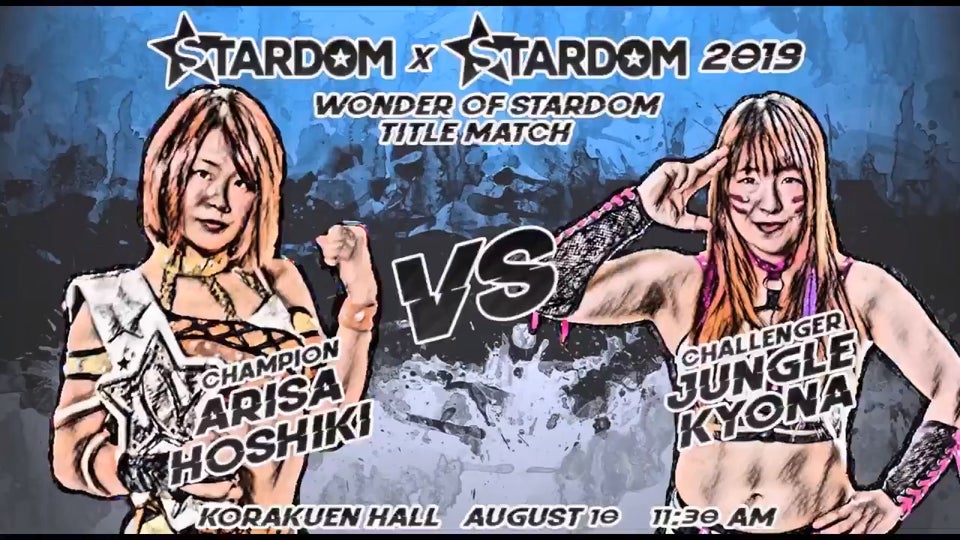
Two of Stardom’s best fighting over the workhorse title was bound to produce a memorable encounter. This is the story of a striker in Hoshiki against the power of Kyona. Early on, Kyona attempts to nullify Hoshiki’s strikes by targeting her legs before transitioning into her power game. Arisa is at her best when using her babyface fire to overcome the odds and fight from behind, with this match being a prime example of that. It creates a closing stretch full of drama, emotion and excellent wrestling.
19. GHC Tag Team Title Match: AXIZ vs The Tough – NOAH The Best

While I named the Violent Giants as my tag team of the year, AXIZ are without a doubt my favourite active team. The chemistry and shared charisma comes from their combined experience to create a magic that only the best teams share. On the other end of the spectrum you have a young and hungry team in The Tough. One that is desperate to prove themselves in the new generation NOAH is building. The more experienced veterans isolate and pick apart the young and inexperienced Inamura. In a star making performance, Inamura shows tremendous heart to withstand this attack and make the tag. Kitamiya comes flying in with an infectious energy that has you rooting for them to pull off the improbable. A perfect example of how to make a new star even in a loosing effort executed to a high standard.
18. AAA World Tag Team Title Match: The Young Bucks vs The Lucha Bros – Double or Nothing
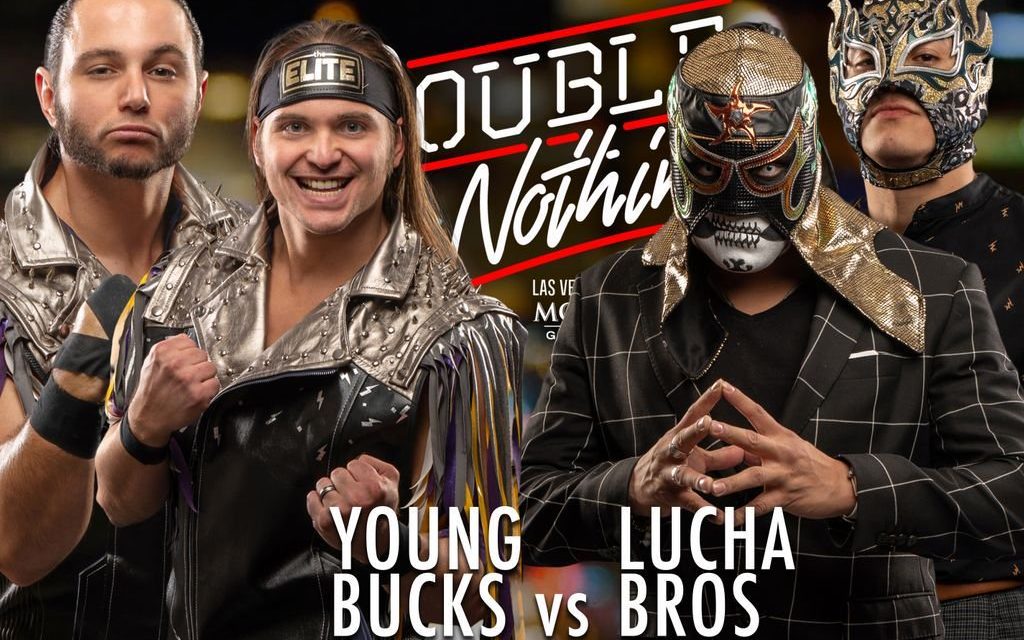
An unrelenting thrill ride of a match from two teams known for their break neck offence. The energy in this match is off the charts and manages to build as the action unfolds. I’ve seen some claim this is just a spot fest. But there are times where I enjoy sitting back and strapping myself in for the pure adrenaline rush these types of matches provide. They grip you in such a way that you can’t take your eyes off the action for a split second. Everything is very crisp and smooth as you would expect from two teams that are at the top of their game right now. Throw in some nice innovative spots and it’s a match that provides a thrill every time you watch it.
17. GHC Heavyweight Title Match: Kaito Kiyomiya vs Kenoh – Navigation For The Future (Night 1)
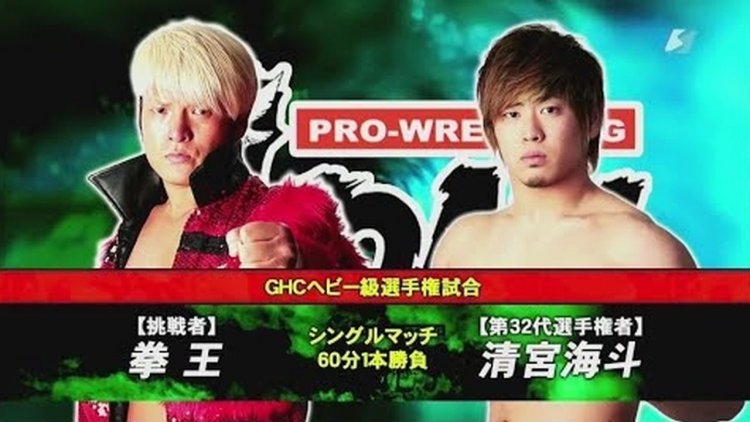
Kaito vs Kenoh has the potential to be a rivalry that is spoken about for generations to come. On the surface, it’s the story of the older brother (Kenoh) being jealous of his younger brother’s success (Kaito) and the attention it has brought him. So, when Kaito won the GHC Heavyweight title in December of 2018, the first challenger had to be Kenoh. Kenoh has the ability to bring out a fire in Kaito that was very rare to see at the time. This match is no exception as the more experienced Kenoh is able to take the advantage early. Each attempt Kaito makes at a comeback is countered by Kenoh who clearly knows his opponent well. It’s this one idea that is gradually built upon as each of Kaito’s attacks start to become more successful. The Korakuen crowd comes along with him as the young underdog champion starts to assert himself. When the dust settles, Kaito has grown from the experience.
16. NXT UK Title Match: Pete Dunne vs WALTER – NXT Takeover: New York

I adore the pacing this match brought to the table. In a world where we can become consumed by the break neck pace of modern wrestling. Dunne and WALTER slowed it down to beautifully blend strong style with a classic British World of Sports edge. WALTER was built as a monster coming in against a champion who genuinely felt unbeatable. It’s that sense of unbeatability which keeps Dunne in the match, fighting to save his championship reign. This match would be ranked higher if not for the odd moments where it felt as though they tried too hard to make the match feel “epic”. Which caused some disconnect for me in what was otherwise an excellent match.
15. NXT North American Title Match: Ricochet vs Johnny Gargano – NXT Takeover: Phoenix
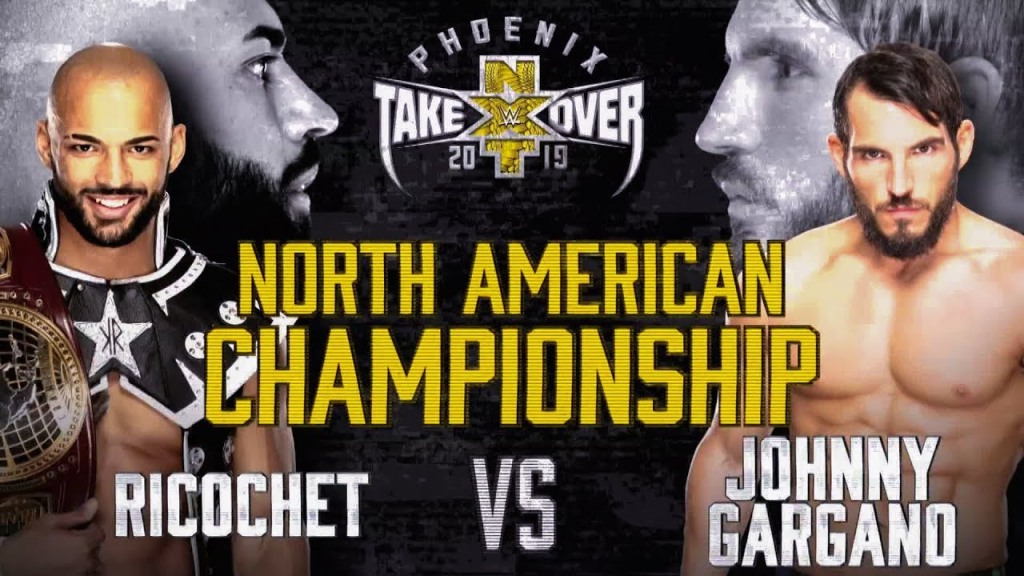
A match that has seemingly become lost in the shuffle during a year jam packed with top tier matches. As with The Young Bucks vs The Lucha Bros, we’re treated to an action-packed thrill ride from two of the best on the planet. It has the feel of an “indie” match but without loosing the storytelling element that NXT does well. The story itself is a simple one, anything you can do I can do better. It’s the fact that an already established star in Gargano feels the need to prove himself which adds a nice layer. As you’d expect from these two, the action is crisp and smooth with neither missing a beat. Gargano adding a sprinkle of heelish tactics helps to keep the match fresh as well. Honestly, go back and rewatch this one as it will be better than you remember.
14. AJPW Triple Crown Title Match: Kento Miyahara vs Jake Lee – Raising An Army Memorial Series (Night 6)
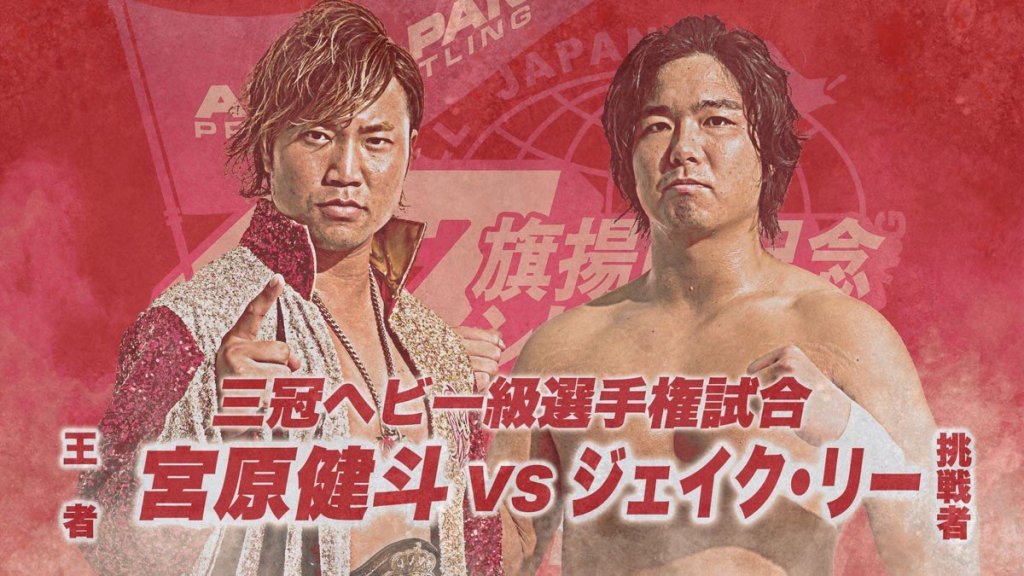
Kento Miyahara vs Jake Lee was one of my favourite feuds of 2019. These two have a long and storied history dating back to their days as partners in NEXTREAM. Jake can often, and rightly, be criticised for showing little to no emotion during matches. The one exception to this is when he’s standing across the ring from Kento. Both men had traded victories in big match situations with Kento taking the first in the Champion Carnival Final and Jake returning the favour in the final of the Odo Tournament. That victory gave him the right to face Kento as a legitimate threat to his historic reign. You can feel the animosity both have for the other as the match quickly descends into a gritty brawl. When the action finally returns to the ring the match starts to settle down. It’s this fact which knocks this match down a few places for me. The second half is far from bad especially when the closing stretch is so strong and has you believing Jake can do the impossible. But the shift in tone creates a level of disconnect that can be hard to shake. Still a wonderful effort however, not quite on the level needed to make it higher up the list.
13. NXT UK Title Match: Tyler Bate vs WALTER – NXT UK Takeover: Cardiff

Another match on this list that had a distinct style and feel to it than what has become the norm for NXT. It’s David vs Goliath with elements the Kings Road and British strong styles mixed in there as well. WALTER’s dominating presence is a near perfect counterpart for Bate’s great underdog fire to create arguably NXT’s finest match. So why is it placed lower than I’m sure some would expect? Well there are two issues that set it back for me. First, it felt as though it went long just for the sake of bragging rights and forcing the issue to make it feel “epic”. Second, at a certain point there is only so much a wrestler can come back from before it loses its effectiveness. It was overused to the point of nausea which took me completely out of the match at times.
12. Go Shiozaki vs Katsuhiko Nakajima – Staring Over (Night 7)

The AXIZ team mates both celebrated their 15th year in wrestling in 2019 with this match marking the special occasion. Before the opening bell sounds, the tone of this match is set. Both men exchange strikes before shaking hands and heading back to their respective corner. This is a match built on mutual respect and the thrill of competition. Yes, these men are friends but neither holds anything back out of respect for the others abilities. You get an insight as to why they are so successful as team as it’s this competitiveness that lifts them above their opponents. The opening is a masterclass is pure striking before gradually transitioning into both men unloading huge shots in an attempt to finish the other. It honestly pains me to leave this out of the top 10.
11. World of Stardom Title Match: Mayu Iwatani vs Kagetsu – Year End Climax
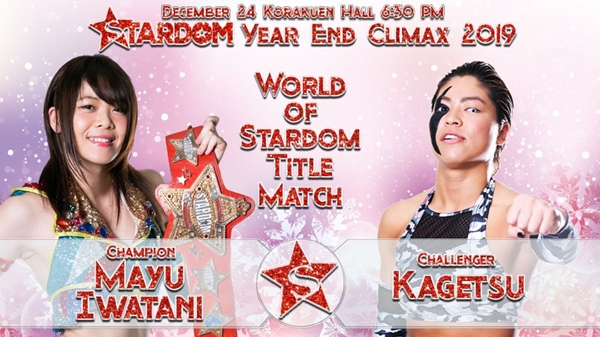
Mayu and Kagetsu have engaged in many wars during their time in Stardom. These two heated rivals are the definition of icons. Once again, they delivered a compelling match that encapsulated their feud perfectly. From the onset it’s clear just how well these two know each other and the underlying respect they have. A slow start quickly heats up with Kagetsu gaining the upper hand by stopping an incoming dive from Mayu. This leads to a brawl on the outside where Kagetsu asserts her dominance culminating in Kagetsu diving off the wall with a double foot stomp to Mayu. From here, the match settles down as Kagetsu starts to brutalise Mayu by targeting her injured ribs with strikes and submissions. Each comeback attempt by Mayu is met with a counter which sends her back down to the mat.
Eventually, Mayu is able to dig deep enough to sustain some offense as we enter the closing stretch of the match. Here the pace quickens again with each sequence building on the last bringing the Korakuen crowd with them. It’s an example of what makes Stardom so special and why they’re able to produce the finest women’s wrestling in the world.
10. KO-D Openweight Title Match: Konosuke Takeshita vs Tetsuya Endo – Peter Pan

My introduction to both men and what an introduction it was. If your preconception of DDT is that of a promotion based around whacky comedy matches. Then this is the match to not only challenge but change this view. DDT has a tremendous pool of highly talented wrestlers with Takeshita and Endo being the companies best. It’s an interesting tale of a babyface both dominating a heel while going to such extremes to target his opponent’s weakness, that you can’t help but feel for the heel. Takeshita attacks Endo’s back with such reckless disregard that you can’t help but start to cheer for Endo. The pacing is excellent with each innovative spot building the tension and drama which then feeds into the story being told. Simply a fantastic match that is a must see.
9. AJPW Triple Crown Title Match: Kento Miyahara vs Naoya Nomura – Dream Power Series (Night 6)

This was unquestionably a star making breakout performance from Nomura that All Japan desperately needed from him. AJPW is still a company rebuilding its image after a long history of talent walkouts and front office disputes. They have the biggest piece of the puzzle in place with their Ace in Kento Miyahara. However, there has been a distinct lack of young competitors close to Kento’s level. That was until Nomura broke away from NEXTREAM and finally challenged Kento (I wrote an in-depth piece on the importance of this match here). Nomura plays the role of hungry young kid wanting to prove himself to perfection. The pure underdog babyface fire he displays has you rooting for him to do the impossible. Kento goes from being slightly cocky and dismissive of Nomura’s challenge to realising he’s going to have to bring his best if he wants to retain the Triple Crown. It’s a prime example of how to create a new star even in defeat. Nomura was no longer the young boy with great potential living in Kento’s shadow. But a legitimate threat to one of the best wrestlers on the planet.
8. NEXTREAM (Kento Miyahara/Yuma Aoyagi) vs Jake Lee/Naoya Nomura – Real World Tag League (Night 19)

The multitude of stories being told in this match serves as the perfect foundation to build a match upon. Both Jake and Naoya have a score to settle with Kento after their failed challenges for the Triple Crown earlier in the year. Jake especially has a grunge against Kento with the tension between the two being palpable. Then there is the animosity between Naoya and Yuma. The two were former tag team partners and were the All Asia Tag Team Champions when Naoya left NEXTREAM. Which resulted in the titles being vacated through no fault of Yuma’s. Then there is Yuma himself and his dynamic with Kento. Throughout the course of the tournament, Kento had been the overly protective big brother to Yuma. Despite the fact Yuma had numerous impressive performances. This adds to an additional layer with Yuma still trying to prove himself to big brother.
The action starts at a slower pace with Kento and Jake laying into one another. Naoya and Yuma are soon tagged in and the action starts to pick up. Most noticeably when Yuma attacks Jake on the ring apron followed by mocking his signature bow. This lights a fire within Jake and from that point the action comes at you at a breakneck pace. All four men raise their game to produce one of the finest tag matches of 2019. The end comes with a finish that feeds into the Kento/Jake rivalry along with teasing future storylines.
7. Wonder of Stardom Title Match: Arisa Hoshiki vs Tam Nakano – Shining Destiny
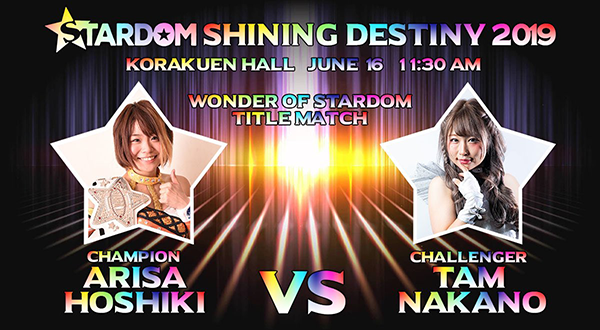
Arisa’s return to Stardom and inclusion into STARS was well received by her fellow stable mates. With one exception: Tam Nakano. Tam’s weariness towards Arisa gradually turned to animosity as Arisa skyrocketed to success, gaining praise and attention in the process. Both women are similar in many ways which led to Tam worrying about her place within STARS. It’s a story that was beautifully told in the background but noticeable enough to make you stop and think. Tam’s cold nature led to Arisa asking to defender her Wonder of Stardom championship against Tam. In the hope of understanding more about her.
The match itself plays beautifully into this story while also building upon it to set up one of my favourite relationships of 2019. It starts with a slow pace as both are feeling the other out while not wanting to make the first mistake. Tam attempts to take away Arisa’s best weapon by grounding her with a series of leg-based submissions. Again, Arisa is at her best when having to fight from under neither. This match is no exception as shows tremendous heart to fight back. Both women are great strikes which leads to hard hitting end to one of my all-time favourite Stardom matches.
6. Open the Twin Gate Title Match: Tribe Vanguard vs R.E.D vs Ishida/Doi – Kobe Pro-Wrestling Festival
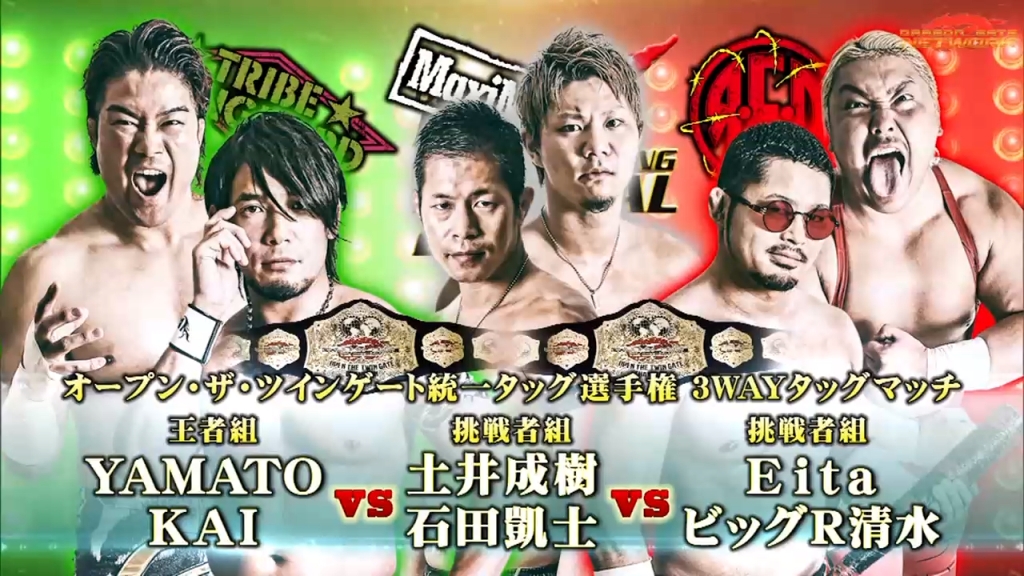
Quite possibly one of the best examples of what makes Dragon Gate so great. Close to 28 minutes of balls to the wall action filled with innovate spots, memorable moments and great stories. Three-way tag matches can be so difficult to pull off successfully. They can have a tendency to become too cluttered or feature long periods of inactivity from a certain team. This is far from the case here as the pacing is spot on. Yes, the action comes at you non-stop but you’re never overwhelmed by it. Each moment is given enough time to breathe before the action builds to another breath-taking moment.
I could write more but, in all honesty, this is one of those matches that you have to watch with your own eyes to fully appreciate.
5. BJW World Strong Heavyweight Title Match: Yuji Okabayashi vs Takuya Nomura – Osaka Surprise 42
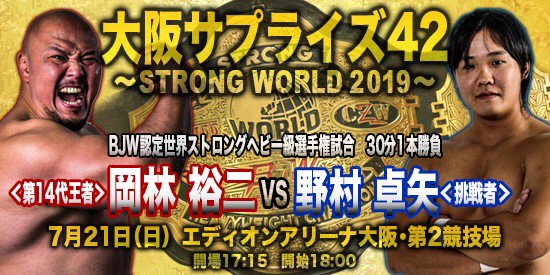
The one match I’ve rewatched the most over the course of last year. Okabayashi grabbed my attention with his incredible run in the Champion Carnival. So, when I heard the buzz surrounding this match, I had to check it out. It’s the story of the young lion in Nomura challenging the old guard in Okabayashi. What ensues is the closets I’ve personally come to witnessing that classic King’s Road style in a modern day promotion. Stiff strikes, big power moves, strong grappling and buckets of heart are on display throughout. Nomura shows no fear in attacking his elder with stiff strikes and grappling. In fact, there are times where Nomura not only welcomes the receipt from Okabayashi but thrives from it. It’s this fighting spirit in face of an unrelenting attack that has you rooting for the young Nomura to dethrone his senior. Okabayashi plays his role perfectly as the varied attack of Nomura give him more than he bargained for. There is moment where you can tell it dawns on Okabayashi that he’ll need to bring his absolute best to defeat Nomura.
As with the aforementioned Miyahara/Nomura match, this is a coming of age moment for Takuya. It proved that he was ready to take that next step and became a legitimate threat in the process. The post-match show of respect from Okabayashi speaks volumes. BJW have a young potential Ace on their hands with Takuya and I just hope they capitalise on this fact.
4. GHC Heavyweight Title Match: Kaito Kiyomiya vs Takashi Sugiura – Global Jr Tag League (Night 7)
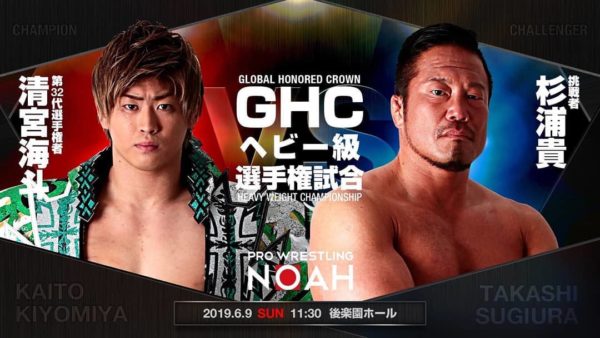
A match that built off their encounter in December of 2018 and really showed just how much Kaito had grown since then. In that December meeting, Sugiura dominated his very young challenger who many viewed as not having any chance of winning. Kaito shocked many that night to claim his first GHC Heavyweight Championship. Skip forward to of 2019 and this was no longer the scared boy who was overwhelmed by the moment. Kaito had grown my confident in his own abilities and as the face of NOAH’s new generation. This is reflected in the story of the match as the opening ten minutes are very even. Both men trade the momentum with neither truly able to gain the upper hand for long. It takes Sugiura flipping the switch to really start asserting his dominance. Which he does by viciously spearing Kaito offer the ring apron and into the guard rail. From that point the attack on Kaito’s back is unrelenting and sold to the point that you start to question if Kaito should carry on. This is backed by a brutal attack from Sugiura who reigns down stiff blows to the young champion.
Once again, we see the heart and passion of Kaito shine through here. Digging deep, he almost seems angry at the attack he’s endured. Returning the favour with one of the nastiest missile dropkicks I’ve ever seen. With the match now back to being even, both men start to unload huge bombs on the other. It’s these types of moments that really make NOAH special for me. When the dust settles the young champion has retained and learned another valuable lesson.
3. Tetsuya Naito vs Shingo Takagi – G1 Climax 29 (Night 14)
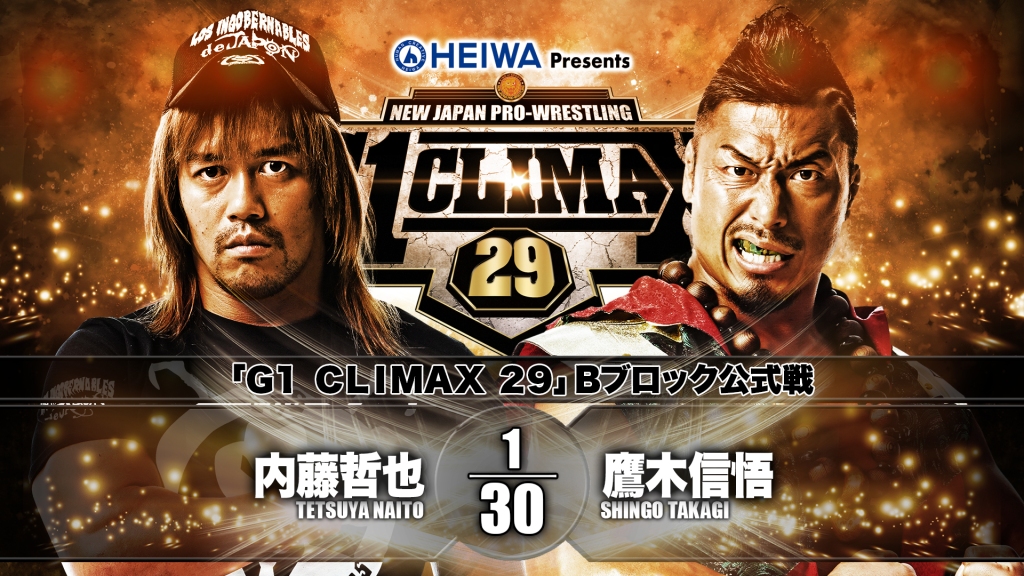
Two long time friends, who went their separate ways, finally squaring off on one of the biggest stages in wrestling. The hype surrounding this match was very high and Shingo and Naito blew away all expectations. It has all the hallmarks of a classic G1 encounter. Intense action, a compelling story, memorable moments, a red hot crowd and a star making performance. For me, this way Shingo’s New Japan coming out party. It showed to those who hadn’t seen him in Dragon Gate why he received so much hype coming in. The pacing is excellent here as the momentum swings back and forth. Neither is able to get a firm advantage as they know each other so well. Naito sells his ass off to make every move from Shingo look that much more dangerous. Shingo never backed down bringing his best to push one of New Japan’s biggest stars to his absolute limit.
Realistically, the outcome was probably never really in doubt here. However, both men had you believing that either could win at any moment. Which was highlighted by Naito’s growing desperation to put Shingo away. The win really did mean that much to both men. A nearly flawless match that will undoubtedly go down as one of the best in G1 history.
2. AJPW Triple Crown Title Match: Kento Miyahara vs Naoya Nomura – Summer Explosion Series (Night 13)
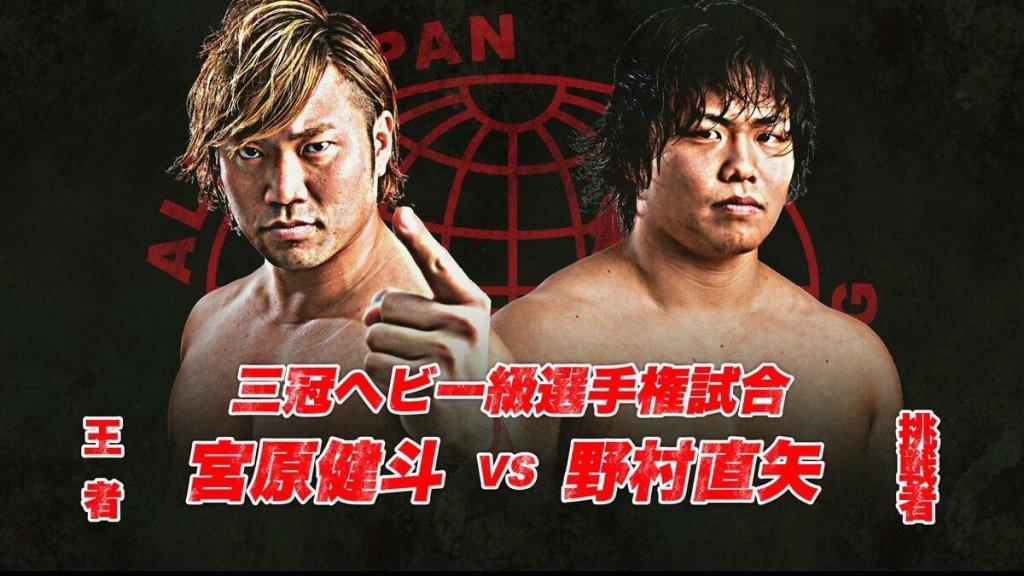
After his Triple Crown challenge in March, Nomura walked into the Champion Carnival with a lot of momentum. Determined to gain another shot at Kento, he put on an impressive performance throughout the tournament. He would barely fall short of making the Finals after falling to Jake Lee in a decision match that came ten minutes after a war with Suwama. While unsuccessful in the Champion Carnival, it gave Nomura a newfound confidence that he could beat the best All Japan has to offer. His confidence only grew after pinning Kento in tag team action to secure this Triple Crown challenge. All of which is reflected in the match that follows. Gone is the young boy trying to find himself and prove he belongs. In his place is a man who knows he can beat the Ace.
Kento plays the perfect foil with a cocky and at times arrogant response to Nomura’s confidence. Afterall, he had recently won his first Champion Carnival and surpassed Suwama for second most combined days as Triple Crown Champion. It’s the combination of Kento’s ego and Nomura’s self confidence that adds a different dynamic to their earlier encounter. Kento’s cockiness lights a fire within Nomura that has him close to beating Kento on numerous occasions. It takes an otherworldly effort from Kento to retain his championship.
1 . Kento Miyahara vs Jake Lee – Champion Carnival Final
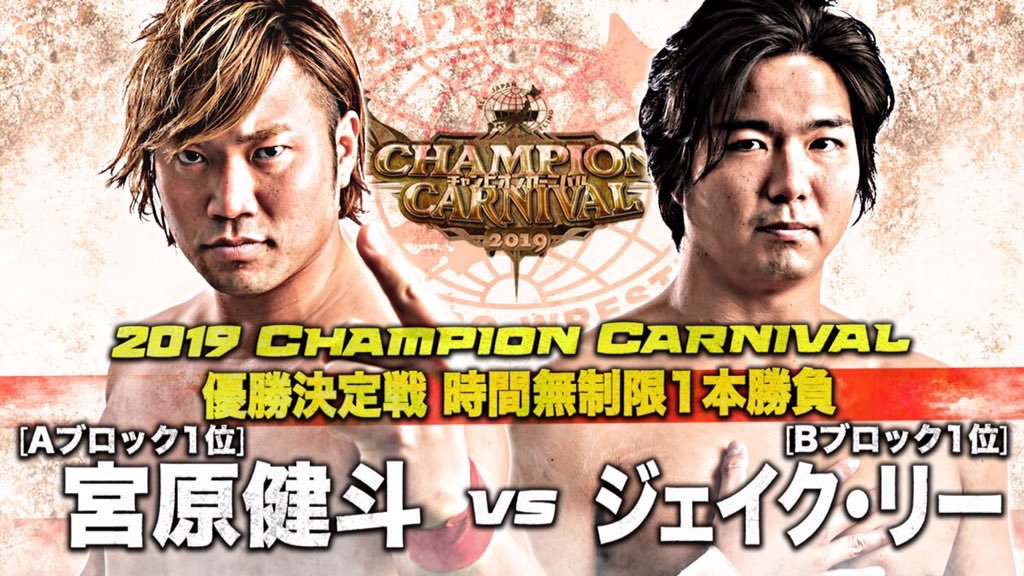
Since forming Sweeper in 2018, Jake Lee had been lost in his quest to prove he was Kento’s equal. The 2019 Champion Carnival changed that perception dramatically as he vanquished past demons to face his once close friend in the Final. Jake is desperate to prove himself while Kento is looking to add to his ever growing legacy. You can feel the animosity radiating off both men during their respective introductions. It’s that intensity which makes this match an absolute classic and my Match of the Year. Both men feed off of it while laying into one another without a care for the other’s wellbeing. Jake can often come off as to reserved in matches but here he has a fire that unleashes a side we rarely see. Each physical exchange feeds into the next as both Kento and Jake up the intensity.
The drama continues to build and build and build to a point where the next big move could easily end the fight. The energy this creates is palpable as both men push themselves past their limits with neither seemingly having the answer. It’s a spectacle that has the Korakuen crowd in a frenzy as every passing moment has you on the edge of your seat. Please take the time to hunt down this match and view it for yourselves. I promise that you won’t be disappointed.
